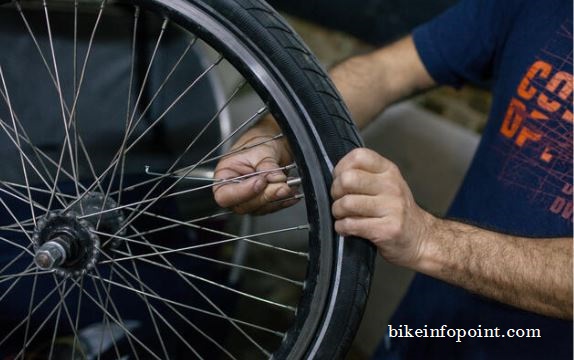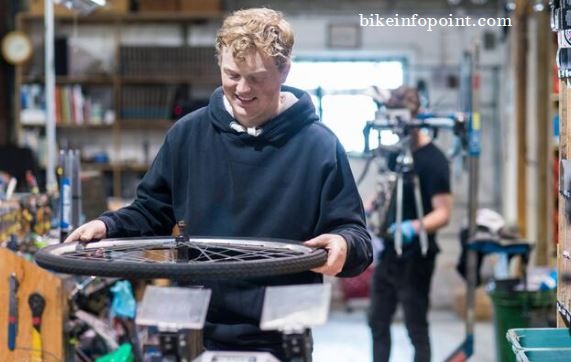
How to Fix Broken Spokes on a Bike
Sure, under the Introduction section of “How to fix broken spokes on a bike”, the importance of fixing broken spokes is discussed. Broken spokes can cause various issues while riding a bike such as instability, wobbling, and difficulty in controlling the bike, which can lead to accidents. Therefore, it is crucial to fix the broken spokes as soon as possible to ensure safe and comfortable riding.
When a spoke breaks, it can put extra pressure on the remaining spokes, which can cause them to break as well. This can cause the wheel to become unstable and wobbly, making it difficult to control the bike.
Fixing a broken spoke can be relatively simple if you have the right tools and materials. However, it is essential to approach the task carefully and follow proper safety procedures to avoid further damage or injury.
Table of Contents
ToggleStep-by-Step Process of Fixing Broken Spokes

A. Identify the broken spokes: Before you can fix a broken spoke, you must first identify which spokes are broken. You can do this by spinning the wheel slowly while examining each spoke for damage. Look for any cracks, bends, or twists in the spoke. A broken spoke may also be loose or missing entirely. Once you have identified the broken spokes, you can move on to the next step.
B. Remove the wheel from the bike: The wheel must be removed from the bike to access the spokes and perform the repair. To do this, flip the bike over so that it rests on the handlebars and seat. Loosen the quick-release lever or axle nuts that hold the wheel in place, and gently remove the wheel from the frame. Be sure to keep the nuts, washers, and any other small parts organized so that they can be easily reassembled later.
C. Remove the tire and tube from the wheel: Once the wheel is removed from the bike, you need to remove the tire and tube to access the spokes. First, deflate the tire completely and remove the tire from the rim by using a tire lever or your hands to pry the bead of the tire away from the rim. Then, remove the tube from inside the tire, being careful not to damage it. Set the tire and tube aside.
D. Replace the broken spokes: Now that you have access to the broken spokes, you can remove them and replace them with new ones. To do this, use a spoke wrench to loosen the nipple that holds the spoke in place. Then, remove the spoke from the hub and the rim. Insert the new spoke into the hub, and thread it through the appropriate holes in the rim. Tighten the spoke nipple with the spoke wrench until it is snug, but not overly tight.
E. True the wheel: Once you have replaced the broken spokes, you need to true the wheel to ensure that it is straight and round. This involves adjusting the tension on the remaining spokes to bring the wheel back into proper alignment. Use a truing stand or your bike frame as a guide to help you see which parts of the wheel are out of true. Use the spoke wrench to tighten or loosen each spoke until the wheel is straight and round.
F. Reinstall the tire and tube: Once the wheel is true, you can reinstall the tire and tube. Start by placing the tube inside the tire and then fitting the tire back onto the rim, making sure that the valve stem is aligned with the hole in the rim. Use your hands to push the bead of the tire back onto the rim, being careful not to pinch the tube. Inflate the tube slightly to ensure that it is properly seated inside the tire.
G. Reattach the wheel to the bike: Finally, you need to reattach the wheel to the bike. Align the wheel with the dropouts on the frame, making sure that it is straight and centered. Then, tighten the quick-release lever or axle nuts until they are snug. Check the wheel to ensure that it spins freely and does not wobble. Once you are satisfied that everything is in order, take your bike for a test ride to ensure that the repair was successful.
Tips and Tricks for Preventing Future Spoke Breakage
A. Keep your wheels properly tensioned: Proper wheel tension is essential to preventing spoke breakage. If the tension is too loose, the spokes can flex excessively and become fatigued over time. On the other hand, if the tension is too tight, the spokes can become overstressed and break prematurely. It is important to have your wheels tensioned to the correct level by a professional mechanic. Additionally, check your wheel tension regularly, and adjust as necessary.
B. Avoid hitting potholes and other obstacles: Hitting potholes, curbs, or other obstacles can put a lot of stress on your wheels and spokes, causing them to break. To prevent this, be mindful of your surroundings while riding and avoid obstacles whenever possible. If you do need to ride over an obstacle, try to do so at a slower speed and with a lighter weight on the bike. Alternatively, you may choose to install wider tires or a suspension system to help absorb shocks and reduce stress on the wheels.
C. Keep your bike well-maintained: Regular bike maintenance can help prevent many problems, including spoke breakage. Be sure to keep your bike clean, lubricated, and properly adjusted. Check your wheels, spokes, and tires for damage regularly, and replace any worn or damaged parts as needed. Additionally, be sure to store your bike in a dry, protected area to avoid rust and other damage.
D. Use high-quality components: Finally, using high-quality components can go a long way in preventing spoke breakage. Choose spokes, rims, and hubs that are made from high-quality materials and are designed to handle the type of riding you do. Look for components that are lightweight yet durable, and that have a good reputation for reliability.
In Conclusion: If you are unsure about how to fix a broken spoke, or if you do not have the necessary tools or experience, it is always better to seek professional help. A bike shop or mechanic can help you repair your bike safely and effectively, and can provide advice on how to prevent future spoke breakage.

